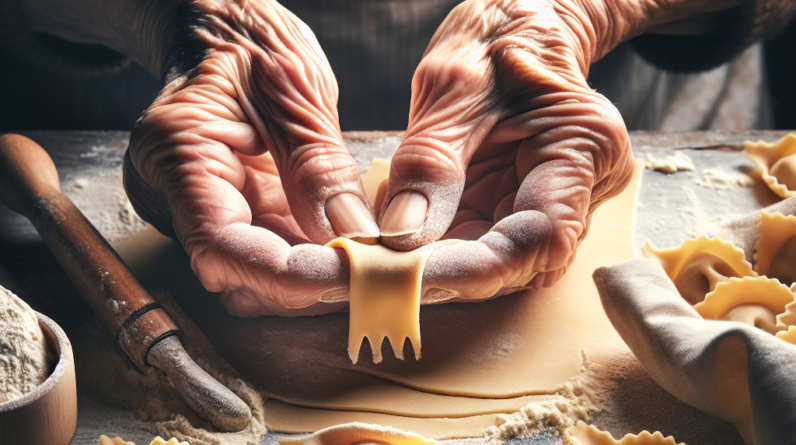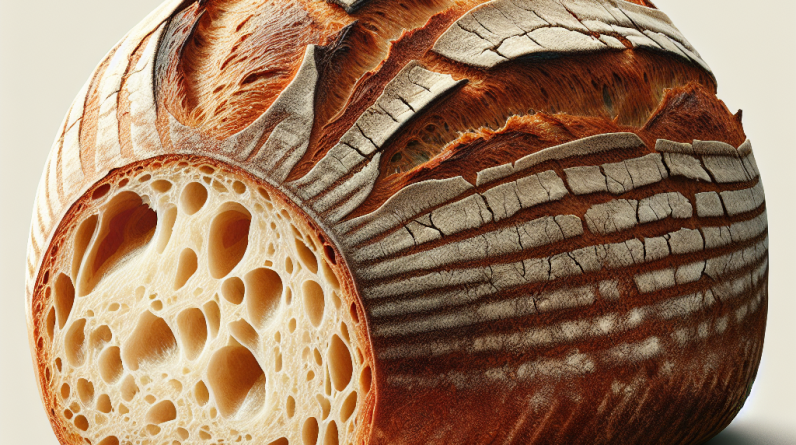If you’ve ever wanted to create the perfect Italian meatball bursting with flavor and boasting the ideal texture, then look no further! In this article, we are excited to share our top tips and techniques for crafting mouthwatering meatballs that will transport you straight to the trattorias of Italy. From selecting the right combination of herbs and spices to achieving that oh-so-desirable melt-in-your-mouth texture, we’ve got you covered. So, grab your apron and get ready to elevate your meatball game to new, delicious heights!

Choosing the Right Meat
When it comes to making Italian meatballs, the first step is choosing the right meat. The most common options are beef, pork, or a combination of both. Each type of meat has its own unique flavor profile that can greatly influence the taste of your meatballs. Beef is known for its rich and savory flavor, while pork offers a slightly sweeter and more tender taste. If you can’t decide between the two, why not go for a blend of beef and pork? This combination can provide the best of both worlds, creating a delicious and well-rounded meatball.
Fresh vs. Ground Meat
Another consideration when choosing the right meat is whether to use fresh or ground meat. Fresh meat refers to cuts that have not been processed or ground, whereas ground meat has gone through a grinding process before being packaged. While both options can yield tasty meatballs, using fresh meat gives you more control over the texture and fat content. You can purchase fresh cuts of meat and grind them yourself using a meat grinder. This allows you to customize the coarseness of the meat and ensure that it’s perfectly suited to your desired texture.
Lean vs. Fatty Meat
One final decision to make when choosing the right meat is whether to use lean or fatty cuts. Lean cuts, such as sirloin or loin, have less fat content and can result in meatballs that are slightly drier. On the other hand, fatty cuts, such as chuck or pork shoulder, have a higher fat content, which adds moisture and flavor to the meatballs. The choice between lean and fatty meat ultimately comes down to personal preference and dietary considerations. If you prefer a leaner option, you can always compensate for the lower fat content by adding additional flavorful ingredients to the mixture.
Adding Flavorful Ingredients
To create a truly delicious Italian meatball, it’s important to incorporate flavorful ingredients into the mixture. These ingredients not only enhance the taste of the meatballs but also contribute to their overall texture and moisture.
Breadcrumbs and Milk Mixture
One essential component to add to your meatball mixture is a combination of breadcrumbs and milk. This mixture serves as a binder and helps to retain moisture, preventing the meatballs from drying out during the cooking process. It’s best to use fresh breadcrumbs, as they absorb the milk more effectively. When combining the breadcrumbs and milk, allow them to sit for a few minutes until the breadcrumbs have absorbed the liquid. This will create a soft and velvety texture in your meatballs.
Onions and Garlic
No Italian meatball is complete without the addition of onions and garlic. These aromatic ingredients bring depth and complexity to the flavor profile of the meatballs. Finely chop the onions and mince the garlic before adding them to the meat mixture. Sautéing the onions and garlic before incorporating them into the meatballs can intensify their flavors even further. The natural sweetness of caramelized onions and the pungent aroma of garlic will give your meatballs that extra punch of flavor.
Parmesan Cheese
Parmesan cheese is another ingredient that adds a burst of savory goodness to your meatball mixture. Grate a generous amount of Parmesan cheese into the meat and mix it thoroughly. The cheese not only enhances the flavor but also contributes to the overall texture by adding a slight creaminess. The umami-rich taste of Parmesan cheese elevates the meatballs to a whole new level of deliciousness.
Fresh Herbs and Spices
To infuse your Italian meatballs with a burst of fresh and vibrant flavors, adding a combination of fresh herbs and spices is key. Options such as parsley, basil, oregano, and thyme work beautifully in meatball recipes. Finely chop the fresh herbs and sprinkle them into the mixture, ensuring an even distribution. In terms of spices, classics like salt, pepper, and red pepper flakes are must-haves. Feel free to experiment with other spices such as paprika or fennel seeds to add a unique twist to your meatballs. Remember, the use of fresh herbs and spices will enhance the overall taste and provide a delightful sensory experience.
Getting the Right Texture
Achieving the perfect texture in your meatballs is essential for a satisfying bite. Here are a few key tips to help you get it right.
Combining Ingredients
Making sure all the ingredients are thoroughly combined is crucial for a consistent and well-textured meatball. Use your hands to mix the ingredients together, ensuring that the meat is evenly distributed and the flavors are well incorporated. Be careful not to overmix, as this can result in tough meatballs. Aim for a uniform mixture that holds together nicely when shaped.
Egg Binder
To help bind the ingredients together and achieve a tender texture, add beaten eggs to your meatball mixture. The eggs act as a binder and contribute moisture, preventing the meatballs from becoming too dry. They also help to hold the meatballs together during cooking. Two eggs per pound of meat is a good rule of thumb, but feel free to adjust depending on the size of your batch.
Avoid Overmixing
While it’s essential to ensure that all the ingredients are well combined, it’s equally important to avoid overmixing the meatball mixture. Overmixing can lead to tough, dense meatballs, as the proteins in the meat become overworked. Mix until the ingredients are evenly distributed, but stop as soon as everything is well incorporated. Remember, the less you handle the mixture, the more tender your meatballs will be.
Consistency of Mixture
The consistency of the meatball mixture also plays a role in achieving the desired texture. If the mixture feels too wet, incorporate additional breadcrumbs or grated Parmesan cheese to absorb excess moisture. On the other hand, if the mixture feels too dry, add a splash of milk or a beaten egg to provide moisture and help bind the ingredients together. The ideal consistency is slightly moist and sticky, allowing the meatballs to hold their shape during cooking without being overly dense or crumbly.
Proper Seasoning Techniques
Proper seasoning is crucial to bring out the best flavors in your Italian meatballs. Here’s how to achieve a harmonious balance of flavors.
Salt and Pepper
Salt and pepper are the foundation of any well-seasoned meatball. The salt enhances the natural flavors of the meat and other ingredients, while the pepper adds a subtle kick of heat. Season the meatball mixture with salt and pepper to taste, keeping in mind that you can always adjust the seasoning later. Start with a small amount and gradually add more if needed, as it’s easier to add than to remove seasoning.
Balancing Flavors
In addition to salt and pepper, it’s important to balance the flavors of your meatballs with other complimentary ingredients. The combination of onions, garlic, Parmesan cheese, and herbs will contribute to the overall flavor profile. Taste the mixture as you go and make adjustments as necessary. Consider adding a dash of Worcestershire sauce or a squeeze of lemon juice to brighten the flavors. It’s all about achieving a harmonious blend of savory, tangy, and aromatic notes.
Testing Seasoning
Before shaping and cooking your meatballs, it’s a good idea to test the seasoning by cooking a small portion of the mixture. Fry or bake a small patty and taste it to ensure it’s seasoned to your liking. This allows you to make any necessary adjustments before committing to the entire batch. Remember, the flavors will concentrate slightly during cooking, so keep that in mind when adding seasoning.

Cooking Methods
There are several cooking methods you can choose from when it comes to preparing your Italian meatballs. Each method offers a slightly different result in terms of texture and flavor. Here are a few popular options:
Baking
Baking meatballs in the oven is a convenient and hands-off cooking method. Preheat the oven to around 375°F (190°C) and place the meatballs on a baking sheet lined with parchment paper. Bake them for about 20-25 minutes or until they reach an internal temperature of 160°F (71°C). Baking produces meatballs with a slightly drier exterior and a tender, juicy interior.
Frying
Frying meatballs in a skillet gives them a crisp and browned exterior, adding a delicious layer of texture. Heat a few tablespoons of oil in a skillet over medium-high heat. Add the meatballs and cook until they’re browned on all sides, ensuring that they reach an internal temperature of 160°F (71°C). Frying imparts a rich, caramelized flavor and creates a slightly firmer texture.
Boiling in Sauce
Simmering meatballs in a flavorful tomato sauce is a classic method that infuses them with even more taste. Shape the meatballs into your desired size and gently drop them into the simmering sauce. Let them cook for about 15-20 minutes or until they’re fully cooked through. Boiling the meatballs in sauce results in tender, moist meatballs that have absorbed the flavors of the sauce.
Creating a Delicious Sauce
No meatball experience would be complete without a delicious sauce to accompany them. Here are a few sauce options to consider:
Traditional Marinara Sauce
A traditional marinara sauce is a classic choice to pair with Italian meatballs. Made with ripe tomatoes, garlic, onions, and herbs, it complements the flavors of the meatball without overpowering it. Saute the garlic and onions in olive oil until fragrant, then add crushed tomatoes and herbs. Simmer the sauce for about 20 minutes to allow the flavors to meld together. The result is a rich and vibrant sauce that perfectly complements your meatballs.
Rich Tomato Sauce with Meatballs
For meat lovers, a rich tomato sauce with meatballs is a delicious option. Start by following the steps for a traditional marinara sauce, then add cooked meatballs directly to the sauce. Allow the meatballs to simmer in the sauce for at least 30 minutes to absorb the flavors. The meaty sauce enhances the flavor of the meatballs, creating a comforting and satisfying meal.
Creamy Alfredo Sauce
If you’re in the mood for something creamy and indulgent, consider serving your meatballs with a homemade Alfredo sauce. Made with butter, heavy cream, Parmesan cheese, and garlic, Alfredo sauce adds a luxurious touch to your meatballs. Melt butter in a saucepan, then add minced garlic and cook until fragrant. Stir in heavy cream and grated Parmesan cheese, and simmer until the sauce thickens. Toss the meatballs in the sauce just before serving, coating them in velvety richness.

Browning the Meatballs
Browning the meatballs is an essential step that adds depth of flavor and an appealing visual appeal. Here are two popular methods for achieving that perfect browned exterior.
Searing in a Skillet
To achieve a beautifully seared crust on your meatballs, heat a skillet over medium-high heat. Add a small amount of oil to coat the pan, then carefully place the meatballs in the hot skillet. Allow them to cook undisturbed for a few minutes until they develop a golden-brown crust on one side. Use tongs to turn the meatballs and repeat the process on all sides until they are evenly browned. Searing in a skillet creates a slightly crispy exterior that adds texture and enhances the overall flavor.
Broiling in the Oven
Another option for browning the meatballs is to broil them in the oven. Preheat the broiler to high and place the meatballs on a baking sheet lined with foil or a wire rack. Position the baking sheet in the upper third of the oven, close to the broiler element. Broil the meatballs for about 5-7 minutes, or until they develop a golden-brown crust. Make sure to watch them closely to prevent burning. Broiling produces meatballs with a nicely caramelized exterior and a tender interior.
Cooking Time and Temperature
Proper cooking time and temperature are crucial to ensure that your meatballs are cooked through, juicy, and safe to eat. Here are a few guidelines to follow.
Internal Temperature
To determine whether your meatballs are fully cooked, check their internal temperature using an instant-read thermometer. The temperature should reach 160°F (71°C) for beef and pork meatballs. Insert the thermometer into the thickest part of a meatball to get an accurate reading. If you’re using a combination of meats, make sure to check the temperature in multiple meatballs to account for any variations.
Cooking Time in Sauce
If you’re cooking the meatballs in sauce, the cooking time will depend on the size of the meatballs and the heat at which the sauce is simmering. Generally, allow the meatballs to simmer in the sauce for about 15-20 minutes, ensuring that they are fully cooked through. To be certain, check the internal temperature to ensure it reaches the recommended 160°F (71°C).
Resting Time
After cooking the meatballs, it’s important to let them rest for a few minutes before serving. This allows the juices to redistribute, resulting in more flavorful and tender meatballs. Let the meatballs rest for about 5 minutes before transferring them to a serving plate or adding them to a dish.
Serving Suggestions
Italian meatballs are versatile and can be enjoyed in various ways. Here are a few classic serving suggestions to inspire you:
With Spaghetti
One of the most iconic ways to enjoy Italian meatballs is with spaghetti. Cook your favorite pasta according to package instructions, then toss it with marinara sauce. Serve the meatballs on top of the spaghetti, garnishing with freshly grated Parmesan cheese and chopped parsley. This classic combination of flavors and textures is bound to satisfy both kids and adults alike.
In a Meatball Sub
For a hearty and satisfying meal, serve your meatballs in a sub sandwich. Split a soft sub roll or baguette, then layer the bottom half with marinara sauce. Add a few meatballs, sprinkle some shredded mozzarella cheese over the top, and place it under the broiler until the cheese is melted and bubbly. Top with fresh basil or arugula for a touch of freshness. The result is a deliciously messy sandwich that showcases the flavors of the meatballs.
As an Appetizer
Italian meatballs also make a crowd-pleasing appetizer. Simply shape the meat mixture into smaller bite-sized balls and cook them according to your preferred method. Serve the meatballs with toothpicks and a side of marinara sauce or any dipping sauce of your choice. This finger food option is perfect for parties or gatherings, allowing your guests to enjoy the flavors of authentic Italian meatballs in a convenient and delicious way.
Storing and Freezing
Italian meatballs can be made ahead of time and stored for future use. Here are some guidelines for storing and freezing meatballs.
Refrigerating Cooked Meatballs
If you have leftover cooked meatballs, store them in an airtight container in the refrigerator for up to 3-4 days. Make sure the meatballs are completely cooled before storing to prevent moisture build-up. To reheat, simply warm them in a saucepan with a little bit of sauce or in the microwave until heated through.
Freezing Raw Meatballs
To freeze raw meatballs, shape them into balls and arrange them on a baking sheet lined with parchment paper. Place the baking sheet in the freezer and let the meatballs freeze until solid, which may take a couple of hours. Once frozen, transfer the meatballs to a freezer-safe bag or container, separating them with parchment paper to prevent sticking. Frozen meatballs can be stored for up to 3-4 months. When ready to cook, defrost them in the refrigerator overnight before following your preferred cooking method.
Reheating Techniques
To reheat frozen cooked meatballs, gently warm them in a saucepan with your favorite sauce, or bake them in the oven at around 350°F (176°C) until they are heated thoroughly. If you’re short on time, you can also microwave the meatballs, but be cautious not to overcook them, as they can become rubbery.
Making flavorful Italian meatballs is a delightful culinary experience. From selecting the right meat to achieving the perfect seasoning, texture, and cooking method, each step contributes to creating meatballs that are tender, juicy, and bursting with flavor. Whether you choose to enjoy them with spaghetti, on a meatball sub, or as an appetizer, Italian meatballs showcase the rich culinary tradition and are sure to become a family favorite.










